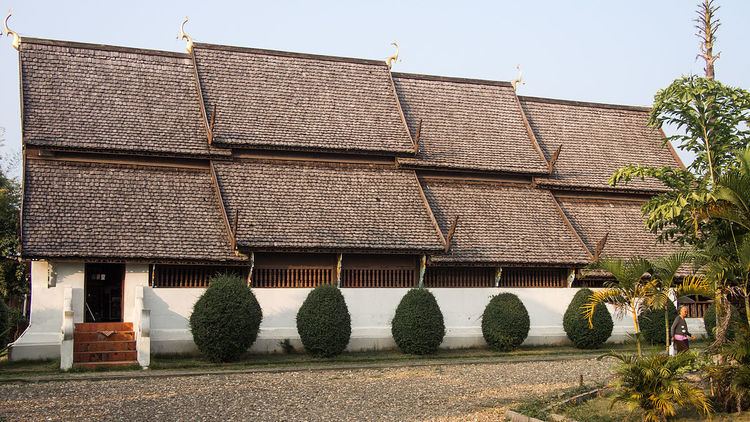China 1,158,989 Thailand 145,236 | Laos 126,229 Myanmar 6,345,236 | |
 | ||
The Dai people (Kam Mueang: ᨴᩱ᩠ᨿ; Thai: ไท; Shan: တႆး [tai˥˩]; Tai Nüa: ᥖᥭᥰ, [tai˥], Chinese: 傣族; pinyin: Dǎizú) are one of several ethnic groups living in the Xishuangbanna Dai Autonomous Prefecture and the Dehong Dai and Jingpo Autonomous Prefecture (both in southern Yunnan, China), but by extension can apply to groups in Laos, Vietnam, Thailand, and Myanmar when Dai is used to mean specifically Tai Yai, Lue, Chinese Shan, Tai Dam, Tai Khao or even Tai in general. For other names, please see the table below.
Contents
Name ambiguity
The Dai people form one of the 56 ethnic groups officially recognized by the People's Republic of China, and are closely related to the Lao and Thai people who form a majority in Laos and Thailand. Originally, the Tai, or Dai, lived closely together in modern Yunnan Province until political chaos and wars in the north at the end of the Tang and Song Dynasty and various nomadic peoples prompted some to move further south into modern Laos then Thailand. As with many other officially recognized ethnic groups in China (See Gaoshan and Yao), the term Dai at least within Chinese usage is an umbrella term and as such has no equivalent in Tai languages who have only more general terms for 'Tai peoples in general' (e.g., Tai Lue: tai˥˩, but this term refers to all Dai people, not including Zhuang) and 'Tai people in China' (e.g., Thai: ชาวไทในจีน'), both of which include the Zhuang for example which is not the case in the Chinese; and more specific terms, as shown in the table below. Therefore the word Dai, like with the aforementioned Yao, is a Han-Chinese cultural concept which has now been adopted by other languages such as English, French and German (see respective Wikipedias). As a solution in the Thai language, however, as in English, the term Tai Lue can be used to mean Dai, despite referring to other groups as in the table below. This is because the two main groups actually bear the same name, both meaning 'Northern Tai' (lue and nüa are cognate).
Although they are officially recognized as a single people by the Chinese state, these Tai people form several distinct cultural and linguistic groups. The two main languages of the Dai are Dai Lü (Sibsongbanna Dai) and Dai Nüa (Daihong Dai); two other written languages used by the Dai are Tày Pong and Tai Dam. They all are Tai languages, a group of related languages that includes Thai, Lao, and Zhuang, and part of the Tai–Kadai language family. Various dialects of the Tai/Dai language family are spoken from Assam, India to Taiwan and Shanxi Province, China. The Dai people follow their traditional religion as well as Theravada Buddhism, and maintain similar customs and festivals (such as Songkran) to the other Tai-speaking peoples and more broadly, in regards to some cultural aspects, to the unrelated dominant ethnic groups of Myanmar, Cambodia and Sri Lanka. They are among the few natives groups in China who nominally practice the Theravada school of Buddhism.
Languages
Peoples classified as Dai in China speak the following Southwestern Tai languages.
Yunnan (1998:150) lists 4 major Tai language varieties.
Exodus
The original areas of the Tai Lue included both sides of the Mekong River in the Sipsongpanna. According to the Tai Lue, there were five city-states on the east bank and six on the west, which with Jinghong formed twelve rice field divisions with all twelve having another 32 small provinces. These were:
On the west bank - Rung, Ha, Sae, Lu, Ong, Luang, Hun, Phan, Chiang Choeng, Hai, Chiang Lo and Mang; On the east bank - La, Bang, Hing, Pang, La, Wang, Phong, Yuan, Bang and Chiang Thong (present-day Luang Prabang). (These names are transcribed according to their Thai Language pronunciations not their Tai Lue(Dai) pronunciations. If transcribed according to their Tai Lue pronunciations they would be as follows: Hung, Ha, Sae, Lu, Ong, Long, Hun, Pan, Cheng Choeng, Hai, Cheng Lo, Mang, La, Bang, Hing, Pang, La, Wang, Pong, Yon, Bang and Cheng Tong)
Some portions of these Tai Lue either voluntarily moved or were forcibly herded from these city-states around one to two hundred years ago, arriving in countries of present-day Burma, Laos and Thailand.
The Tai Yong
In the 14th century Chao Sunanda, son of the ruler of Chiang Rung, led a following of Tai Lue from Chiang Rung to Yong in present-day Shan State.
Given this history, the Tai Yong are the Tai Lue. In Thailand, these people are still known as Tai Lue Mueang Yong, as distinct from the Tai Khoen of Kengtung (Kyaingtong) and the Tai Yai of Shan state generally. The term Shan is generally not used in Thai.
Tai Lue in Thailand
In Thailand there are Tai Lue in many provinces of the upper regions of Northern Thailand; these provinces are:
Economy
The Dai people are typically farmers, growing a variety of tropical crops such as pineapples, in addition to the staple crop of rice. Many Dai live near the Mekong river where it meanders through the far south of Yunnan.
